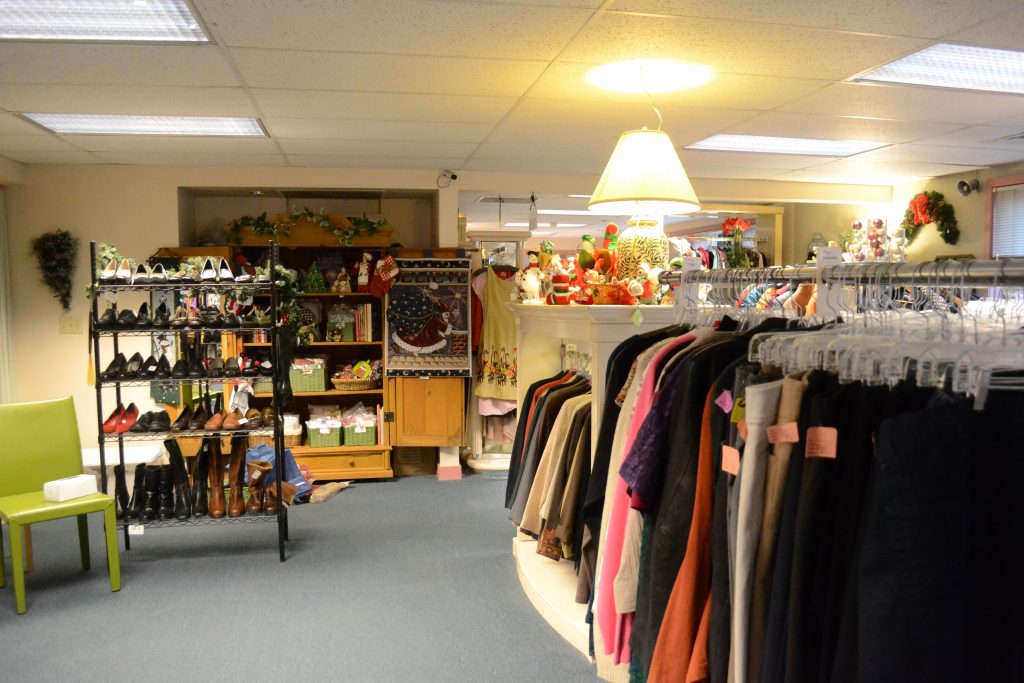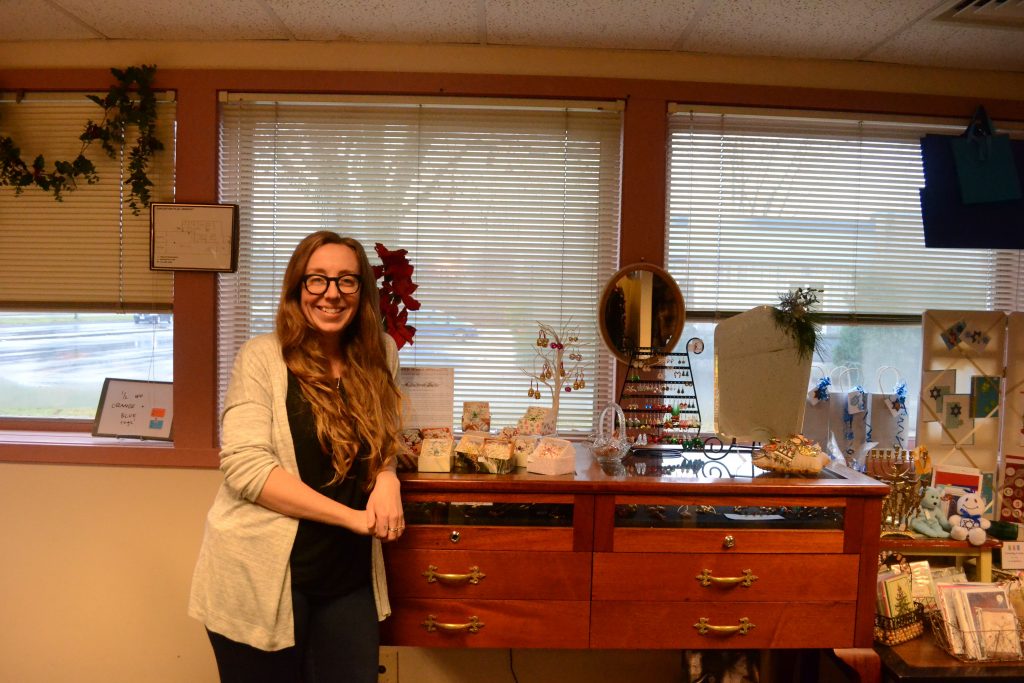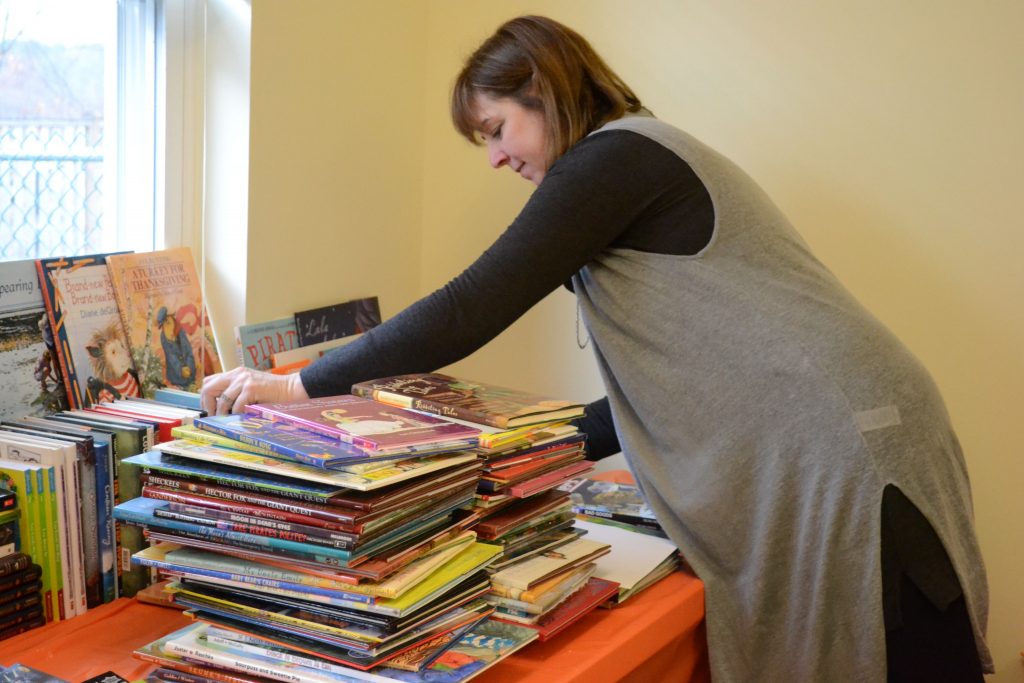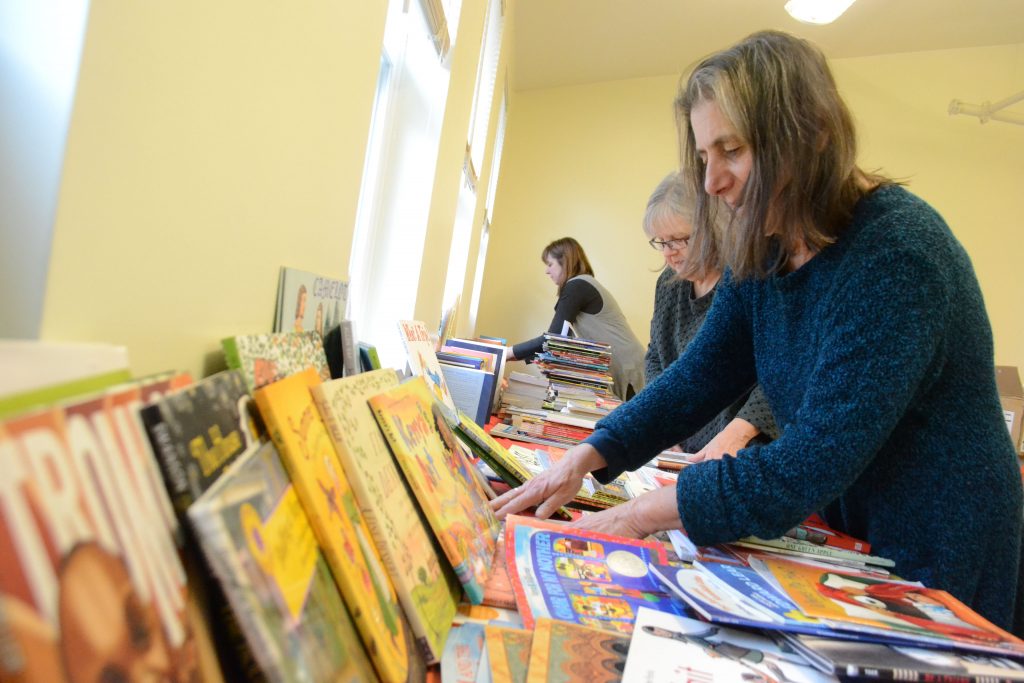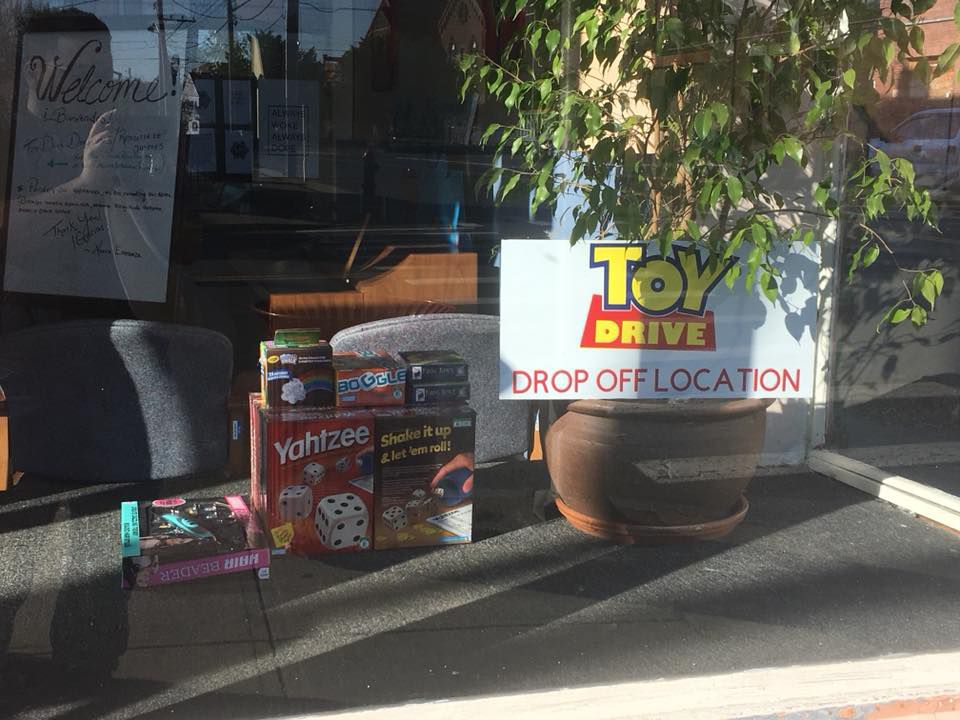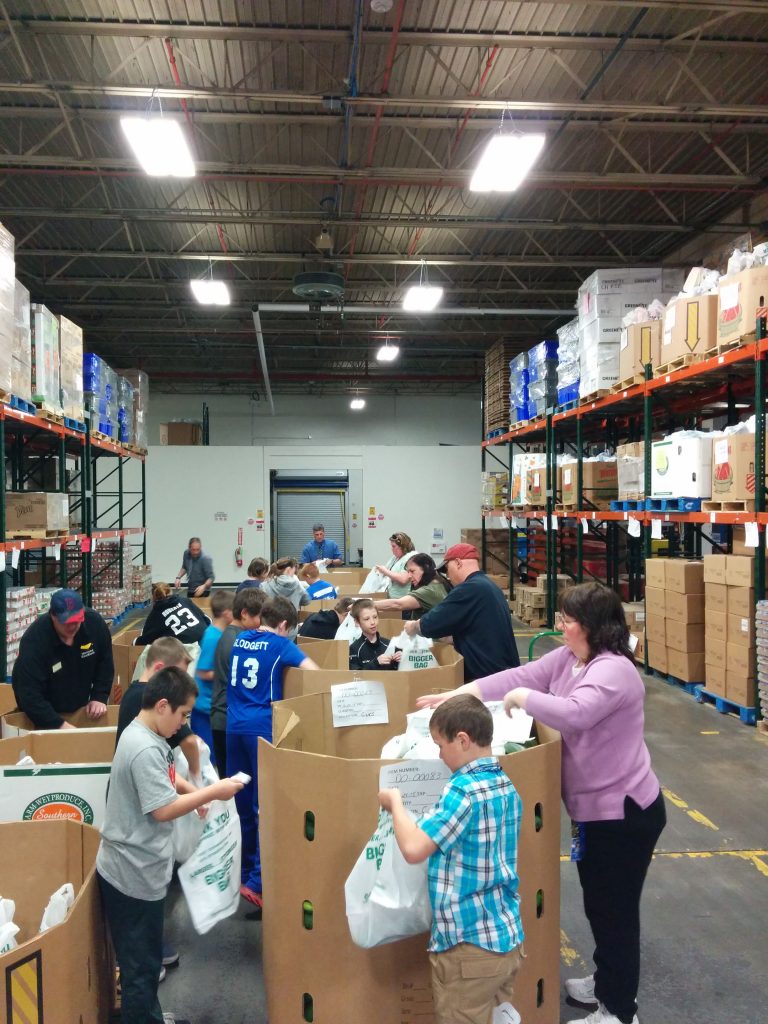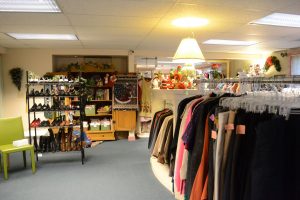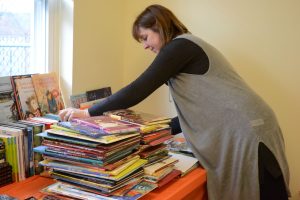
Heidi Stemple, a local children’s book author, sorts books at the Amherst Survival Center. Photo by Meg Bantle.
Many people call this the season of giving. The Network for Good Digital Giving Index found that in 2015, 29 percent of giving occurred in December alone, and that 11 percent of giving happened in the last three days of the year. With those three days fast approaching, I wanted to shed a light on places where you can make non-monetary donations locally. Donating money to local organizations is a fantastic way to give back, and many organizations prefer money. But there are some places that need things other than cash. Whether it’s food and clothing, toys and games, books, or volunteer hours, there are many goods and services that local nonprofits need that they don’t have the resources to buy. Making a non-monetary donation can be a great way to give back to your community even if you are short on cash. In my opinion it’s also a more rewarding way to give because you have to go out and participate and in most cases actually visit the organization that you are donating to.
Help a Child Start their Library
At the Amherst Survival Center, you can donate lots of different things, including money, food for the community meals and food pantry, and clothes for the community store. This holiday season, you can also donate new books, games, and winter accessories for the organization’s holiday gift program. The gift program has been running through the Survival Center in some capacity for eight years. After several different iterations, the Survival Center now strives to provide every child that uses the food pantry with new books, gifts, games, and winter accessories every holiday season.
Tracey Levy, program director at the Survival Center, said that the organization is intentionally seeking games and books instead of toys.
“It feels like something that’s going to last your family for years,” Levy said.
The Survival Center also works with local children’s book authors and illustrators to get donated copies of signed books. Organizations like Reader to Reader and the Eric Carl Museum also donate.
“It’s a way for some children to start their libraries with beloved, signed copies of books,” Levy said.
Several local authors were helping to organize books with other volunteers on the first day of distribution, December 1. The Survival Center is collecting books for kids of all ages, from cardboard books to young adult novels.
“The books are the enduring gifts,” said Corinne Demas, who is the author of 32 books for kids of all ages.
Levy said that even though the Survival Center is a basic needs organization, it is also a community center.
“We really want to address the less tangible things that happen in people’s lives,” Levy said. “For people with children, the holidays are a very stressful time. This is a way to recognize the whole person and other things besides food, clothing, and health care.”
The Survival Center is collecting gifts through Friday, Dec. 15, so check out their website at https://amherstsurvival.org/holiday-gift to see a list of donation locations.
Gifts for the Entire Family
In Holyoke, the influx of Puerto Rican families after Hurricane Maria shed light on a growing need for many children this holiday season. This winter, Nueva Esperanza, Inc. is expanding its annual Three Kings Day celebration in January to include a two-month toy drive to provide gifts to 500 children from families in need.
Nueva Esperanza, Inc. is a community-based organization in South Holyoke that seeks, “to be a hub for community, creation, and culture for the Puerto Rican/Afro-Caribbean community.” This January 6, Nueva Esperanza will bring back the Three Kings Day celebration after an eight-year hiatus, but this year is going to be a little different. For the rest of December, Nueva Esperanza is collecting toys, gift cards, and event tickets for over 100 children who moved to Holyoke from Puerto Rico after Hurricane Maria and additional Holyoke students who already lived in Holyoke and are also in need.
“That poverty and adversity already exists here,” Executive Director Nelson Rafael Roman said.
Roman said that there is a large population of Holyoke students who have experienced trauma this year, who are homeless or in transition, or who are living in poverty. Based on data from 2000 – 2013 on City Data, the neighborhood where Nueva Esperanza is based has an average income of less than $15,000 a year and a 41 percent unemployment rate. Roman also said there have been several fires this year that have resulted in families with children being displaced from their homes.
Roman is hoping to collect 1,000 gifts, so that each child in need gets two. Nueva Esperanza is putting more emphasis on gifts that families can do together, like movie passes, tickets to local theater, and passes to local museums. New, unwrapped toys are also welcome, but games and puzzles are preferred.
“That way they have something they can do as a family, to escape from their normal awhile,” Roman said.
The Nueva Esperanza website has more information about how many gifts are needed for each age group. There are over 150 children between 2nd and 4th grade who are hoping to receive gifts to be distributed at a Three Kings Day party on January 6. Roman explained that in Latin culture, particularly in Puerto Rico, Christmas is generally a primarily religious holiday while Three Kings Day is when gifts are given.
If you would like to donate a gift, Nueva Esperanza has a warehouse space at the Puerto Rican Flag Center at 409 Main Street in Holyoke.
Winter Volunteering at Local Food Banks
Many people know that you can donate money to local food banks, including the Vermont Foodbank and the Food Bank of Western Massachusetts, but did you also know that you can volunteer your time there? In addition to many other things, food banks collect, sort, and distribute food to other food distribution centers throughout their region, but they need volunteers to help them do that sorting, especially in the winter.
In the wintertime, money gets a lot tighter for everyone,” said Ed Katuska, Administrative Coordinator at the Brattleboro Distribution Center.
Katuska explained that people spend more money on clothing and heat in the winter, so there is less money for food. Luckily, there are usually more food donations coming in around the holidays, so orders from local food shelves, food pantries, and shelters can get bigger.
Vermont Foodbank’s Brattleboro warehouse is the distribution center for the southern half of Vermont and relies on volunteer work to do the job of sorting food. When food arrives from donors like C & S Wholesale Grocers, Price Chopper, Hannaford’s, it needs to be sorted by category and quality, to make sure nothing is expired or rotting. Then it is grouped to be sent on to the local community center that ordered it. Katuska said that there are over 2,000 people volunteering with the Vermont Foodbank statewide.
“Food comes in and goes out so quickly,” Katuska said. “If it wasn’t for the volunteers we would be lost.”
To volunteer to sort food at your local food bank, fill out an application at either https://www.vtfoodbank.org/give-time or https://www.foodbankwma.org/get-involved/volunteer.
Clean your Closet for a Cause
An easy local donation to make is to donate something that you have, but no longer need or want. You can donate a variety of gently used high-quality clothing, accessories, shoes, and household goods to the Hospice Shop of the Fisher Home in Amherst that will have the same impact to the organization as a cash donation would.
“If you donate goods to us, that turns around and becomes a monetary donation,” said Ali Diamond, Director of the Hospice Shop. “We have customers who have probably raised us thousands of dollars.”
Hospice of the Fisher Home is an independent nonprofit that specializes in providing end-of-life care by addressing the health needs and community needs of patients. They opened the Hospice Shop eight years ago to raise funds to support their services. Donating items to sell at the Hospice Shop and shopping there are both great ways to support the Fisher Home’s mission and to help ensure that people have access to the care they offer.
You can also volunteer at the Hospice Shop. When items are donated (Monday – Friday, 10 a.m. – 3 p.m.) volunteers immediately sort the items based on type and style. The Hospice Shop has a calendar of many different themed days, including holidays and seasonal turnovers. The store uses themes to ensure that each item has the maximum opportunity to be sold. Diamond said that the Hospice Shop raises about a quarter of a million dollars a year for Hospice of the Fisher Home.
“We all put all of this energy into it,” Diamond said. “We try to make as much money as possible because it all goes to the Fisher Home.”
Diamond also explained that the hospice shop will also often support other community organizations who might need something from their donations.
“We see our stuff as a resource for whoever needs it,” Diamond said. “We see ourselves as part of a larger community.”
The Hospice Shop is located at 55 University Drive in Amherst. Store hours, contact information for volunteering, and a description of what items are accepted is available at http://www.fisherhome.org/p/hospice-shop.html.

